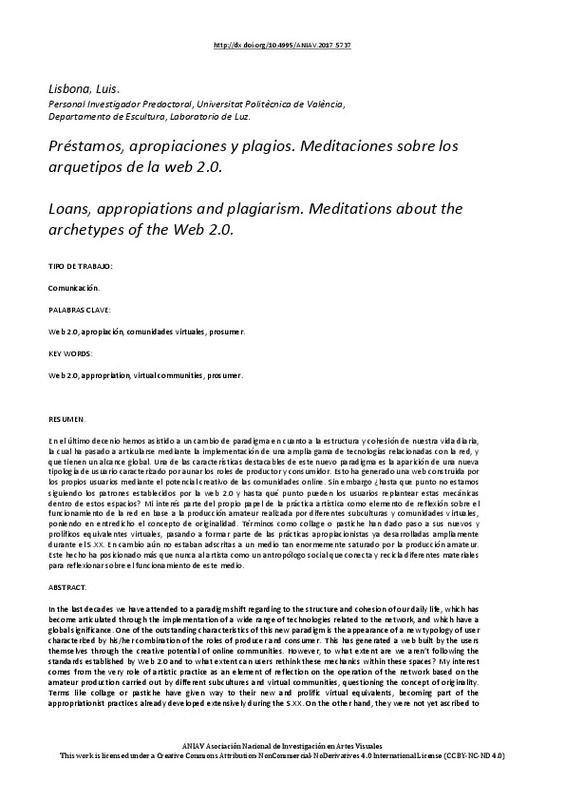|
[EN] In the last decades we have attended to a paradigm shift regarding to the structure and cohesion of our daily life, which has become articulated through the implementation of a wide range of technologies related to ...[+]
[EN] In the last decades we have attended to a paradigm shift regarding to the structure and cohesion of our daily life, which has become articulated through the implementation of a wide range of technologies related to the network, and which have a global significance. One of the outstanding characteristics of this new paradigm is the appearance of a new typology of user characterized by his/her combination of the roles of producer and consumer. This has generated a web built by the users themselves through the creative potential of online communities. However, to what extent are we aren’t following the standards established by Web 2.0 and to what extent can users rethink these mechanics within these spaces? My interest comes from the very role of artistic practice as an element of reflection on the operation of the network based on the amateur production carried out by different subcultures and virtual communities, questioning the concept of originality. Terms like collage or pastiche have given way to their new and prolific virtual equivalents, becoming part of the appropriationist practices already developed extensively during the S.XX. On the other hand, they were not yet ascribed to an environment so enormously saturated by amateur production. This fact has more than ever positioned the artist as a social anthropologist who connects and recycles different materials to reflect on the operation of this medium.
[-]
[ES] En el último decenio hemos asistido a un cambio de paradigma en cuanto a la estructura y cohesión de nuestra vida diaria, la cual ha pasado ha articularse mediante la implementación de una amplia gama de tecnologías ...[+]
[ES] En el último decenio hemos asistido a un cambio de paradigma en cuanto a la estructura y cohesión de nuestra vida diaria, la cual ha pasado ha articularse mediante la implementación de una amplia gama de tecnologías relacionadas con la red, y que tienen un alcance global. Una de las características destacables de este nuevo paradigma es la aparición de una nueva tipología de usuario caracterizado por aunar los roles de productor y consumidor. Esto ha generado una web construida por los propios usuarios mediante el potencial creativo de las comunidades online. Sin embargo ¿hasta que punto no estamos siguiendo los patrones establecidos por la web 2.0 y hasta que punto pueden los usuarios replantear estas mecánicas dentro de estos espacios? Mi interés parte del propio papel de la práctica artística como elemento de reflexión sobre el funcionamiento de la red en base a la producción amateur realizada por diferentes subculturas y comunidades virtuales, poniendo en entredicho el concepto de originalidad. Términos como collage o pastiche han dado paso a sus nuevos y prolíficos equivalentes virtuales, pasando a formar parte de las prácticas apropiacionistas ya desarrolladas ampliamente durante el S.XX. En cambio aún no estaban adscritas a un medio tan enormemente saturado por la producción amateur. Este hecho ha posicionado más que nunca al artista como un antropólogo social que conecta y recicla diferentes materiales para reflexionar sobre el funcionamiento de este medio.
[-]
|









